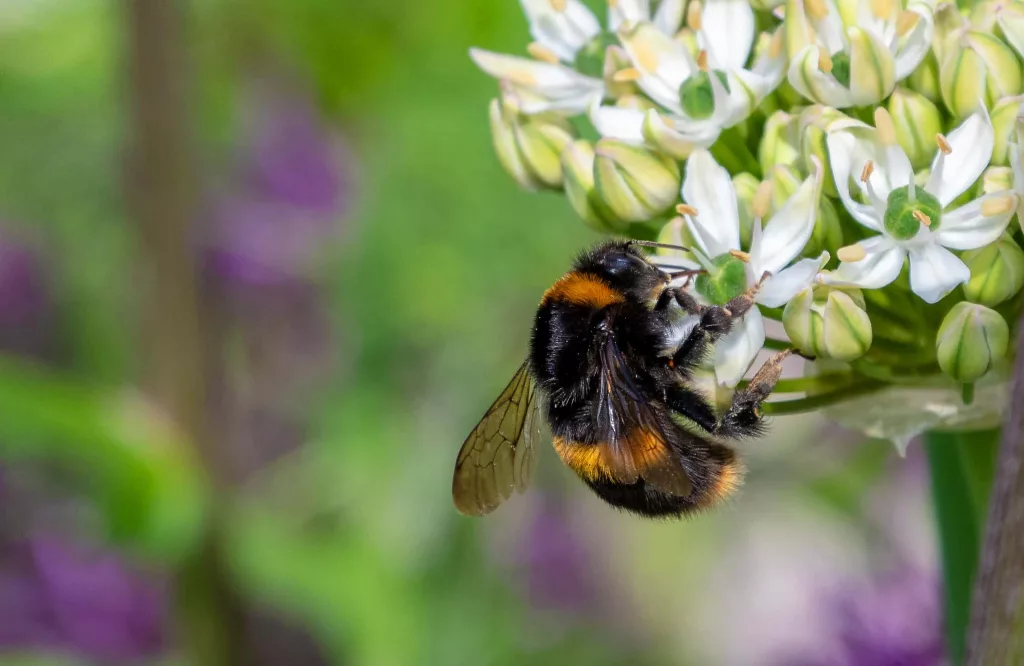How you respond to the sight of a bumble bee could seriously impact your food supply and the well-being of farmers all across the region of Michigan’s Great Southwest.
Whenever we stumble onto a bee’s nest or find a swarm in the backyard or neighborhood the knee jerk reaction is to escape without being stung, even if it means killing the attackers. Before you delve into a full frontal attack, the agricultural community hopes that you’ll find an alternative solution that does not destroy those valuable insects which are in serious decline, creating a direct impact in the fields and orchards of our entire region in SW Michigan and beyond.
While many scientists are focused on the decline of honey bees, relatively few study bumble bees. The good news is that a new study provides an estimate on bumble bee population and distributions across Michigan in the past century. The bad news is that these results are dramatically low, and they mirror what’s happening across the Americas, Europe and Asia, too.
Michigan State University led the study, which compared current distributions of bumble bee species across the state to the information gleaned from museum specimens collected as far back as the 1880s. The research, published in the current issue of Ecology, shows that half of the bumble bee species studied have declined by more than 50-percent.
Thomas Wood is an Entomology Postdoctoral Researcher at Michigan State. He tells us, “Bumble bees are important pollinators of plants across natural habitats, where they help support the seeds and berries that birds and other animals depend on.” As lead author of the study, Wood says, “They also are effective pollinators of many fruits and vegetables that are important for healthy human diets.”
He encourages us to take blueberries, for example. Bumble bees are highly efficient pollinators of this leading Michigan fruit crop in our region. To extract the pollen necessary for fertilization, the blossom needs to be shaken vigorously, and bumble bees are expert at vibrating the flowers to shake out the pollen.
Wood reports, “In Michigan, there are 19 species of bumble bees and around 445 species of other bees.” Wood led the study in the lab of Rufus Isaacs, and Entomologist at MSU. He contends, “Many of Michigan’s key crops depend on them. In fact, about 50-percent of cherry pollination is carried out by wild bees.”
Wood’s team scoured the state of Michigan and compared the distribution of 12 different bumble bee species across the state’s 83 counties before and after the year 2000. Some of the biggest declines include:
- Rusty patched bumble bee – 100-percent
- American bumble bee – 98-percent
- Yellow banded bumble bee – 71-percent
- Yellow bumble bee – 65-percent
Even though the study focused on Michigan, its findings hold lessons for other regions around the globe, and some of them are positive. A couple of success stories include the common eastern bumble bee and the brown belted bumble bee, which increased by 31-percent and 10-percent, respectively.
Why did some species remain stable or increase their ranges while other species declined?
Researchers investigated the kinds of plants each bumble bee species visited by removing pollen from the specimens. Bumble bees carry their pollen on their back legs, and that can be removed and identified under a microscope, even decades after the bee was alive. When looking at those pollen loads, the researchers found some consistent patterns.
Wood says, “Species that declined collected pollen from fewer species of plants and seem to have a narrower range of plants they visit for pollen,” and notes, “In contrast, the stable species visit a much wider variety of plants. This suggests that picky eaters are less able to switch if a favorite plant isn’t available.”
The next phase of the research will try to understand why bumble bee species with narrow diets do not show diet flexibility.
Voicing concern, Wood says, “Most of the declining bumble bee species in Michigan fly in the summer, feeding on prairie plants and other flowers of open countryside,” and suggests, “Fewer types of plants flower in summer compared to the spring. We also know that prairies have been lost over the last century so summer bumble bees may have been hit twice due to a loss of their preferred habitat and a reduced ability to adapt to this change.”
Kelsey Graham, MSU entomologist, and Jason Gibbs, University of Manitoba, also contributed to the study. Their research was funded in part by the USDA National Institute for Food and Agriculture, through the Great Lakes Great Bees project. You can find their work at the link below:
https://esajournals.onlinelibrary.wiley.com/doi/full/10.1002/ecy.2697
Michigan State University has been working to advance the common good in uncommon ways for 160 years. One of the top research universities in the world, MSU focuses its vast resources on creating solutions to some of the world’s most pressing challenges, while providing life-changing opportunities to a diverse and inclusive academic community through more than 200 programs of study in 17 degree-granting colleges.






